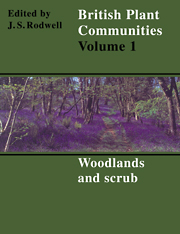Book contents
- Frontmatter
- Contents
- List of Figures
- Foreword
- Preface and Acknowledgements
- Preamble
- General Introduction
- Woodlands and Scrub
- Introduction to Woodlands and Scrub
- Key To Woodlands and Scrub
- Community Descriptions
- W1 Salix Cinerea-Galium Palustre woodland
- W2 Salix Cinerea-Betula Pubescens-Phragmites Australis Woodland
- W3 Salix Pentandra-Carex Rostrata Woodland
- W4 Betula Pubescens-Molinia Caerulea Woodland
- W5 Alnus Glutinosa-Carex Paniculata Woodland
- W6 Alnus Glutinosa-Urtica Jzozca Woodland
- W7 Ainus Glutinosa-Fraxinus Excelsior-Lysimachia Nemorum Woodland
- W8 Fraxinus Excelsior-Acer Campestre-Mercurialis Perennis Woodland
- W9 Fraxinus Excelsior-Sorbus Aucuparia-Mercurialis Perennis Woodland
- W10 Quereus Robur-Pteridium Aquilinum-Rubus Fruticosus Woodland
- W11 Quereus Petraea-Betula Pubescens-Oxalis Acetosella Woodland
- W12 Fagus Sylvatica-Mercurialis Perennis Woodland
- W13 Taxus Baccata Woodland
- W14 Fagus Sylvatica-Rubus Fruticosus Woodland
- W15 Fagus Sylvatica-Deschampsia Flexuosa Woodland
- W16 Quereus spp.-Betula spp.-Deschampsia Flexuosa Woodland
- W17 Quereus Petraea-Betula Pubescens-Dicranum Majus Woodland
- W18 Pinus Sylvestris-Hylocomium Splendens Woodland
- W19 Juniperus Communis Ssp. Communis-Oxalis Acetosella Woodland
- W20 Salix Lapponum-Luzula Sylvatica Scrub
- W21 Crataegus monogyna-Hedera helix scrub
- W22 Prunus Spinosa-Rubus Fruticosus Scrub
- W23 Ulex Europaeus-Rubus Fruticosus Scrub
- W24 Rubus Fruticosus-Holcus Lanatus Underscrub
- W25 Pteridium Aquilinum-Rubus Fruticosus Underscrub
- Index of Synonyms to Woodlands and Scrub
- Index of Species in Woodlands and Scrub
- Bibliography
W17 - Quereus Petraea-Betula Pubescens-Dicranum Majus Woodland
Published online by Cambridge University Press: 04 July 2020
- Frontmatter
- Contents
- List of Figures
- Foreword
- Preface and Acknowledgements
- Preamble
- General Introduction
- Woodlands and Scrub
- Introduction to Woodlands and Scrub
- Key To Woodlands and Scrub
- Community Descriptions
- W1 Salix Cinerea-Galium Palustre woodland
- W2 Salix Cinerea-Betula Pubescens-Phragmites Australis Woodland
- W3 Salix Pentandra-Carex Rostrata Woodland
- W4 Betula Pubescens-Molinia Caerulea Woodland
- W5 Alnus Glutinosa-Carex Paniculata Woodland
- W6 Alnus Glutinosa-Urtica Jzozca Woodland
- W7 Ainus Glutinosa-Fraxinus Excelsior-Lysimachia Nemorum Woodland
- W8 Fraxinus Excelsior-Acer Campestre-Mercurialis Perennis Woodland
- W9 Fraxinus Excelsior-Sorbus Aucuparia-Mercurialis Perennis Woodland
- W10 Quereus Robur-Pteridium Aquilinum-Rubus Fruticosus Woodland
- W11 Quereus Petraea-Betula Pubescens-Oxalis Acetosella Woodland
- W12 Fagus Sylvatica-Mercurialis Perennis Woodland
- W13 Taxus Baccata Woodland
- W14 Fagus Sylvatica-Rubus Fruticosus Woodland
- W15 Fagus Sylvatica-Deschampsia Flexuosa Woodland
- W16 Quereus spp.-Betula spp.-Deschampsia Flexuosa Woodland
- W17 Quereus Petraea-Betula Pubescens-Dicranum Majus Woodland
- W18 Pinus Sylvestris-Hylocomium Splendens Woodland
- W19 Juniperus Communis Ssp. Communis-Oxalis Acetosella Woodland
- W20 Salix Lapponum-Luzula Sylvatica Scrub
- W21 Crataegus monogyna-Hedera helix scrub
- W22 Prunus Spinosa-Rubus Fruticosus Scrub
- W23 Ulex Europaeus-Rubus Fruticosus Scrub
- W24 Rubus Fruticosus-Holcus Lanatus Underscrub
- W25 Pteridium Aquilinum-Rubus Fruticosus Underscrub
- Index of Synonyms to Woodlands and Scrub
- Index of Species in Woodlands and Scrub
- Bibliography
Summary
Synonymy
Caithness birch woods Crampton 1911 p.p.; Betuletum tomentosae Moss 1911 p.p.; Quercetum roboris Tansley 1939 p.p.; Quercetum petraeaeIsessiliflorae Tansley 1939 p.p.; Betuletum Oxaleto-Vaccine- tum McVean & Ratcliffe 1962 p.p.; Vaccinium-rich birchwood association McVean 1964a p.p.; Blechno-Quercetum (Br.-Bl. & Tx. (1950) 1952) Klötzli 1970p.p.; Loch Lomond oakwoods Tittensor & Steele 1971 p.p.; Betula pubescens-Vaccinium myrtillus Association Birks 1973 p.p.; Birch-oak woodland Peterken 1981 p.p.; Birch woodland Peterken 1981 p.p.; Trientali-Betuletum pendulae Birse 1982 p.p.; Woodland plot type 18 Bunce 1982 p.p.; Blechno-Quercetum (Br.-Bl. & Tx. (1950) 1952) Birse 1984 p.p.
Constant species
Betula pubescens, Quercus petraea, Deschampsia flexuosa, Vaccinium myrtillus, Dicranum majus, Hylocomium splendens, Plagiothecium undulatum, Pleurozium schreberi, Polytrichum formosum, Rhytidiadelphus loreus.
Rare species
Goodyera repens, Adelanthus decipiens, Sematophyllum demissum, S. micans.
Physiognomy
The Quercus petraea-Betula pubescens-Dicranum majus woodland, like its counterpart on less base-poor soils, the Quercus-Betula-Oxalis woodland, is almost always dominated by either oak or birch or various mixtures of the two trees, though in this community there is a more pronounced shift towards Quercus petraea and Betula pubescens as the characteristic species. Q. petraea is very common here and, in western Britain, where the bulk of the stands of this community are located, Q. robur makes only a very local, though sometimes conspicuous, contribution: it predominates, for example, in certain localities on Dartmoor, in Devon, notably at Wistman's Wood (Harris 1921, Christy & Worth 1922, Tansley 1939, Wigston 1974), and robur elements can also be detected elsewhere, as among the oaks at Keskadale in Cumbria and in some stands in Ross & Cromarty (Jones 1959, Gardiner 1974, Wigston 1974). However, it is only in eastern Scotland that there is any more widespread switch to Q. robur and hybrids, and here there seems a stronger likelihood of the oaks having originated from planted stock (Jones 1959, Gardiner 1974, Birse 1982, 1984).
Oak is often abundant in the canopy of this community though, even where it dominates, the tree cover is typically rather open and low, only rarely exceeding 20 m and generally being less than 15 m. In extreme situations, oak forms a very dwarfed canopy, as at Wistman's Wood (Harris 1921, Christy & Worth 1922) and Keskadale (Leach 1925), where many trees are less than 4 m and the most exposed individuals even shorter, their crowns wind-shaped into the contours of a rocky landscape.
- Type
- Chapter
- Information
- British Plant Communities , pp. 278 - 299Publisher: Cambridge University PressPrint publication year: 1991



